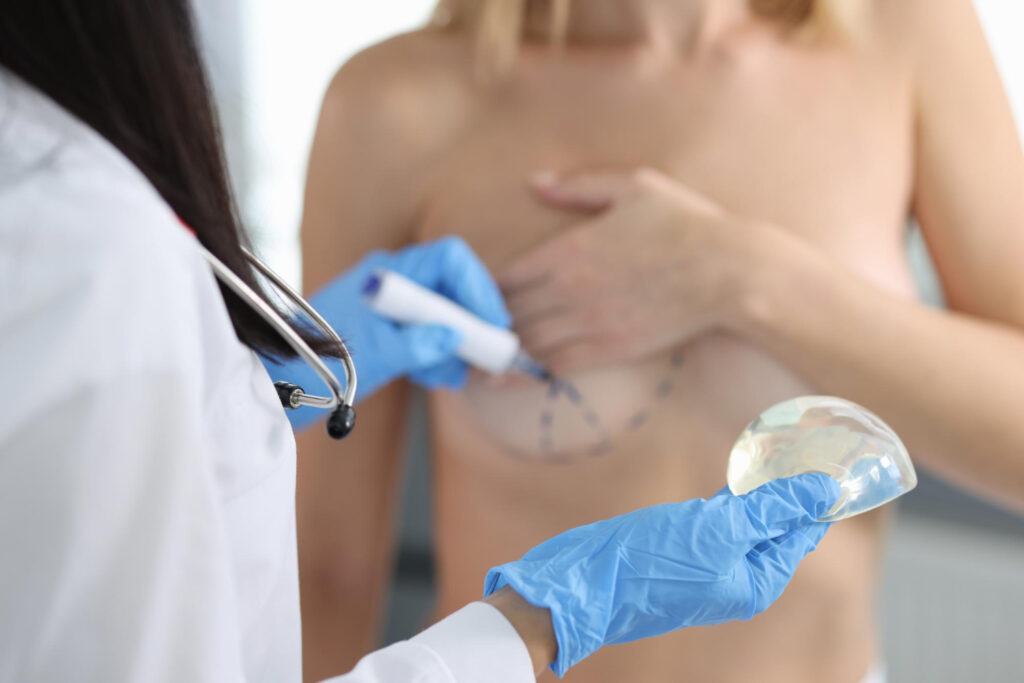Have you ever found yourself confused by these terms while researching breast enhancement surgery? Many women face the same question when they start considering procedures to improve the appearance of their breasts.
The truth might surprise you: there isn’t exactly a difference between breast augmentation vs implants — in fact, implants are simply the most common method used to perform breast augmentation.
What does breast augmentation mean?
The term breast augmentation refers to a surgical procedure designed to increase breast volume and improve their overall shape.
The most common techniques include the insertion of breast implants or fat transfer, where fat is removed from another part of the body and injected into the breasts for a more natural enhancement.
This surgery is often recommended for women who experience breast asymmetry, loss of volume after pregnancy or breastfeeding, or who simply wish to enhance their body proportions for personal or aesthetic reasons.
Recovery usually takes a few weeks, depending on the individual’s health and the surgical method chosen. Regular follow-up appointments with the plastic surgeon help ensure safe healing and lasting results.
What breast implants are?
Breast implants are medical devices used to enhance or restore breast volume during a breast augmentation procedure. They come in different types, shapes, and sizes to match each patient’s anatomy and desired result.
There are two main types of implants commonly used in the United States:
- Silicone implants, filled with a cohesive silicone gel that feels more like natural breast tissue.
- Saline implants, filled with a sterile saltwater solution after being placed in the breast pocket, offering a slightly firmer feel.
Implants also vary in size, projection, shape (round or teardrop), and surface texture (smooth or textured). This wide range allows surgeons to customize the procedure according to each woman’s body proportions and goals.
All implants currently available in the U.S. are approved by the Food and Drug Administration (FDA), which ensures that they meet strict safety and quality standards.
During the consultation, the surgeon evaluates factors like body structure, skin elasticity, and lifestyle to guide a personalized choice that aligns comfort, safety, and aesthetic expectations.
Breast augmentation vs implants: what’s the difference
Although the terms are often used interchangeably, breast augmentation vs implants actually describe two different things.
Breast augmentation refers to the procedure itself — the surgical process that enhances and reshapes the breasts. Breast implants, on the other hand, are the devices used during that surgery to achieve the desired size and contour.
Here’s a quick comparison between the two concepts:
| Aspect | Breast Augmentation | Breast Implants |
| Definition | Surgical procedure that enhances and reshapes the breasts | The device inserted during surgery |
| Method | Can involve implants or fat transfer | Uses only an implant |
| Indication | To redefine volume and improve shape | To replace or increase size specifically |
| Options | Implants, fat transfer, or a combination | Silicone or saline implants |
In short, breast augmentation is the overall procedure, while breast implants are one of the most common tools used to achieve that result.
What are the costs involved?
According to the American Society of Plastic Surgeons (ASPS), the average cost of a breast augmentation procedure in the United States is around $4,500, but this figure covers only the surgeon’s fee.
Additional expenses typically include:
| Item | Estimated Cost |
| Surgical facility fee | $800 – $1,200 |
| Anesthesia | $600 – $1,000 |
| Implants | $1,000 – $1,500 |
| Preoperative exams | $200 – $500 |
| Medications and surgical bras | $100 – $300 |
The total investment can range from $6,000 to $12,000, depending on geographic location, the surgeon’s experience, and the type of implant selected.
In West Palm Beach, patients at Illusions Plastic Surgery have access to financing options that help make the procedure more affordable.
Are there risks you should be aware of?
Like any surgical procedure, breast augmentation carries potential risks that deserve careful consideration:
- Capsular contracture: hardening of the scar tissue that forms around the implant.
- Rupture or leakage: while modern implants are highly durable, they may eventually rupture over time.
- Changes in sensitivity: some women experience temporary or permanent changes in nipple sensation.
- Asymmetry: subtle differences between the breasts can occur.
- Need for future surgeries: implants are not lifetime devices and may require replacement after 10–20 years.
The Food and Drug Administration (FDA) recommends that women with silicone implants undergo periodic MRI scans to monitor implant integrity and detect silent ruptures.
Read more:
👉 Breast Implant Revision Surgery: When and why to consider replacement
Why choose Illusions Plastic Surgery?
At Illusions Plastic Surgery in West Palm Beach, FL, every breast enhancement journey begins with personalized attention and expert care.
Our board-certified plastic surgeons combine experience, precision, and artistry to help each patient achieve results that look balanced and natural.
The clinic offers a fully equipped surgical facility, advanced technology, and a supportive environment focused on safety and comfort.
Each treatment plan is tailored to the patient’s anatomy, lifestyle, and goals, ensuring that the chosen technique—whether implants or fat transfer—aligns with her expectations.
FAQ — breast augmentation vs implants
1. Are breast augmentation and breast implants the same thing?
Not exactly. Breast augmentation refers to the surgical procedure that enhances breast size and shape, while breast implants are the devices used in most augmentation surgeries to achieve that result.
2. What are the main types of breast implants available in the U.S.?
The two most common options are silicone and saline implants. Silicone implants offer a softer, more natural feel, while saline implants are filled with sterile saltwater and allow for minor adjustments in size. Both are approved by the FDA for safety.
3. How long do breast implants usually last?
Breast implants are not considered lifetime devices. On average, they last 10 to 20 years, depending on factors such as the type of implant, body response, and lifestyle. Regular medical check-ups and imaging tests help monitor their condition.
4. Can breast augmentation be done without implants?
Yes. Some patients choose fat transfer breast augmentation, which uses fat from another part of the body to increase breast volume naturally. This option suits those looking for subtle enhancement rather than a significant size increase.
5. What factors should be discussed with the surgeon before surgery?
During consultation, patients should talk about their desired breast size, body proportions, implant type, and recovery expectations. A personalized evaluation helps define which method — implants or fat transfer — best aligns with their goals and anatomy.







